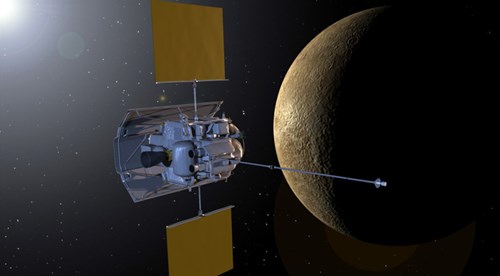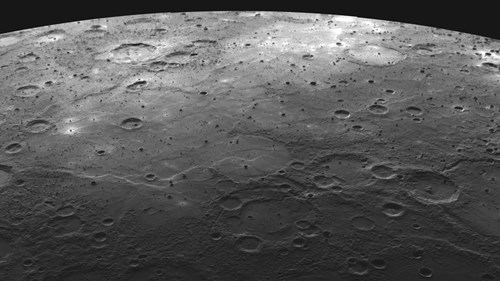Uncover the mysteries of Mercury
Mercury is the smallest planet in the solar system and is always a mystery to humans. However, recent images provided by Messenger spacecraft have helped scientists uncover somewhat of the mysterious veil of Mercury, according to BBC.
New discoveries about Mercury
The US Aeronautics and Space Agency (NASA) has discovered many mysteries about Mercury thanks to the space probe Messenger. The ship finished its mission in May 2015.

Messenger spacecraft flying around Mercury - (NASA screenshot)
Mercury has a thin atmosphere. In the daytime, due to the sun, burning sunlight on the planet's surface reaches 430oC. While at night, the temperature drops very low, inside the craters at the two polar regions of the planet can descend to minus 180 ° C.
Mercury has many similarities with the moon , such as: gray surface and barren soil; both appear a lot of meteor craters , remnants of terrible collisions with comets and asteroids.

Mercury's surface has many craters like the moon - (NASA screenshot)
However, scientists still cannot explain Mercury's formation process and why it has magnetic fields , what happened on the journey during its 4.5 billion years of existence.
Scientists also discovered another mystery on Mercury that made them unable to explain clearly. On the surface of the planet appeared many cracks , or it could also be giant cliffs stretching over a large area. They are like giant steps, the largest rung is more than 1,000 km long and 3 km high.
Scientists have come up with some hypotheses to explain this phenomenon. They argue that the geologic rocks can be pushed away, cracked and raised at the same time to form fractures or cracks on Mercury's surface. The cause of this phenomenon may be because Mercury core cools down over time, causing the planet's size to shrink.

Meteorite pits and faults on the planet's surface - (NASA screenshot)
Exploring Mercury will help scientists better understand planets in the solar system as well as the operating structure of the universe. In August 2004, NASA launched Messenger space probe in Florida state (USA).
Although Mercury is only 91 million kilometers from Earth but because Messenger does not have enough fuel to fly straight into orbit, it has made many round flights to take advantage of the gravity of Earth, Venus and the Sun.
The ship has flown 7.8 billion km over 6 years. In 2011, Messenger invaded Mercury orbit and became the first space probe to do this.
Messenger has been flying around Mercury for 4 years and sent to Earth more than 280,000 images. Later, under the influence of gravity, the probe crashed into Mercury and ended its mission.
- Things you may not know about Mercury
- Uncover the secret of the
- Overview of Mercury
- Announcing more new findings about Mercury
- The unexpected similarity between the moon and Mercury
- Photos never published about Mercury
- What happens when you drink mercury?
- Mercury is no different from a raisin fruit turning around the Sun.
- Mist containing mercury poisoned the US city
- Symptoms of mercury poisoning and how to prevent it
- Astonishing image: Mercury passes between the Earth and the Sun
- Mercury inversely causes society to be confused? Science says it's okay
 Van Allen's belt and evidence that the Apollo 11 mission to the Moon was myth
Van Allen's belt and evidence that the Apollo 11 mission to the Moon was myth The levels of civilization in the universe (Kardashev scale)
The levels of civilization in the universe (Kardashev scale) Today Mars, the sun and the Earth are aligned
Today Mars, the sun and the Earth are aligned The Amazon owner announced a secret plan to build a space base for thousands of people
The Amazon owner announced a secret plan to build a space base for thousands of people After 1,800 years, ghosts from ancient Mayan cities are still enough to harm people
After 1,800 years, ghosts from ancient Mayan cities are still enough to harm people  Which planet is the smallest in the Solar System?
Which planet is the smallest in the Solar System?  Why is tuna high in mercury?
Why is tuna high in mercury?  As the smallest planet in the Solar System, Mercury was once as big as Earth
As the smallest planet in the Solar System, Mercury was once as big as Earth  Ancient beauties were crazy about painting their lips red to seduce men: Who would have thought that this thing is extremely poisonous!
Ancient beauties were crazy about painting their lips red to seduce men: Who would have thought that this thing is extremely poisonous!  The truth about the 'eternal immortality' drug that killed Qin Shi Huang
The truth about the 'eternal immortality' drug that killed Qin Shi Huang 